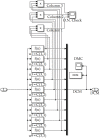Microsatellite Uncertainty Control Using Deterministic Artificial Intelligence
- PMID: 36433317
- PMCID: PMC9699355
- DOI: 10.3390/s22228723
Microsatellite Uncertainty Control Using Deterministic Artificial Intelligence
Abstract
This manuscript explores the applications of deterministic artificial intelligence (DAI) in a space environment in response to unknown sensor noise and sudden changes in craft physical parameters. The current state of the art literature has proposed the method, but only ideal environments, and accordingly this article addresses the literature gaps by critically evaluating efficacy in the face of unaddressed parametric uncertainties. We compare an idealized combined non-linear feedforward (FFD) and linearized feedback (FB) control scheme with an altered feedforward, feedback, and deterministic artificial intelligence scheme in the presence of simulated craft damage and environmental disturbances. Mean trajectory tracking error was improved over 91%, while the standard deviation was improved over 97% whilst improving (reducing) control effort by 13%.
Keywords: adaptive control; control systems; deterministic artificial intelligence; feedback; feedforward.
Conflict of interest statement
The authors declare no conflict of interest. Authors have no personal circumstances or interest that may be perceived as inappropriately influencing the representation or interpretation of reported research results.
Figures

















References
-
- NASA Begins to Build Satellite Mission to Improve Hurricane Forecasting. Release 15-173, 15 August 2015. [(accessed on 22 July 2022)]; Available online: https://www.nasa.gov/press-release/nasa-begins-to-build-satellite-missio....
-
- NASA Image Use Policy. [(accessed on 22 July 2022)]; Available online: https://gpm.nasa.gov/image-use-policy.
-
- Wie B., Barba P. Quaternion feedback for spacecraft large angle maneuvers. J. Guid. Con. Dyn. 1985;8:360–365. doi: 10.2514/3.19988. - DOI
-
- Wie B., Weiss H., Arapostathis A. Quarternion feedback regulator for spacecraft eigenaxis rotations. J. Guid. Con. Dyn. 1989;12:375–380. doi: 10.2514/3.20418. - DOI
-
- Bilimoria K., Wie B. Time-Optimal Three-Axis Reorientation of a Rigid Spacecraft. J. Guid. Con. Dyn. 1995;43:446–452. doi: 10.2514/3.21030. - DOI
MeSH terms
LinkOut - more resources
Full Text Sources

